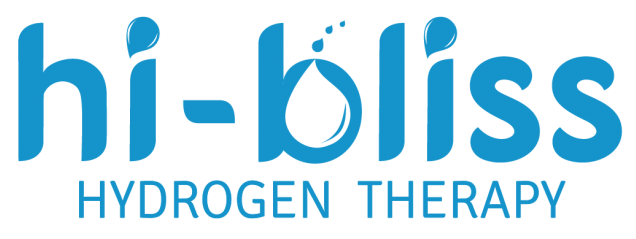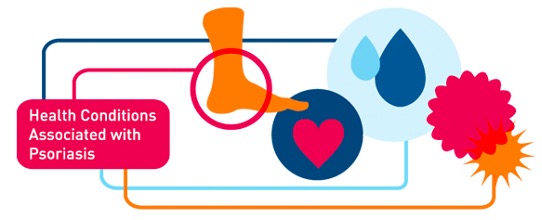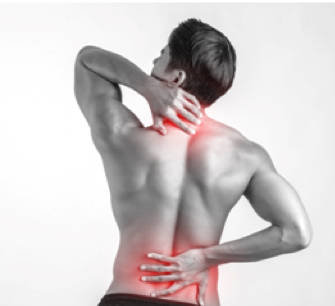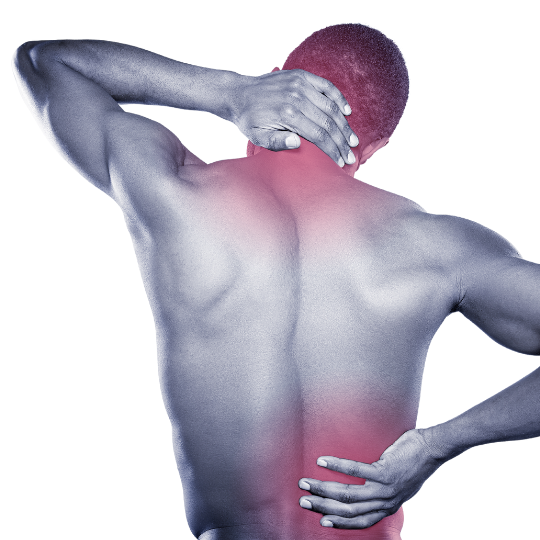
Psoriasis, though is not a condition that is life threatening (although it has been suggested that the condition increases the risk of heart attack). People with more severe psoriasis may be more likely to develop certain other conditions. Around a quarter of people with one autoimmune disease will go on to develop at least one more, and people with severe psoriasis are more likely to develop conditions like thyroid dysfunction or coeliac disease. That still means that three-quarters of people with psoriasis will not be diagnosed with another autoimmune condition – it’s just important to be aware of possible links and risk factors when other symptoms are being investigated.
Health Conditions associated with Psoriasis
People with psoriasis and psoriatic arthritis are at an elevated risk of developing a comorbidity. A comorbidity is a disease or condition that occurs because of or is related to a health condition that you have, such as psoriasis.

Psoriatic arthritis (PsA) causes swelling, pain and stiffness in the joints and in areas where tendons and ligaments connect to bone. PsA is the most common comorbidity of psoriasis. An estimated 30 to 33 percent of people living with psoriasis also experience PsA

Cardiovascular Disease
Cardiovascular disease (also known as heart disease) refers to numerous conditions including heart attack, stroke, heart failure, arrythmia (irregular heart rhythm) and heart valve problems.

Metabolic Syndrome
Metabolic syndrome refers to the presence of increased blood pressure, high blood sugar, excess body fat and abnormal cholesterol levels, which increase the risk of heart disease, stroke and type 2 diabetes.
Diabetes
Type 2 diabetes (also called insulin resistance) refers to cells in the body that do not respond normally to insulin. Normally insulin works to let blood sugar into the cells in the body to use as energy. Type 2 diabetes may increase the risk of cardiovascular disease, vision loss and kidney disease.

Anxiety and Depression
People with anxiety disorders often struggle with intense feelings of anxiety, worry, fear and/or panic. Anxiety can interfere with daily activities and may last a long time. People with depression experience a persistent sad mood that lasts a long time and interferes with daily activities.

Other Conditions
Includes Obesity, Cancer, Hypertension, Dyslipidemia, Inflammatory Bowel Disease (IBD) such as Ulcerative colitis and Crohn’s disease.
What is Psoriatic Arthritis ?
Psoriasis is also associated with psoriatic arthritis (PsA). PsA is a chronic, inflammatory disease of the joints and the places where tendons and ligaments connect to bone. Inflammation can lead to swelling, pain, fatigue and stiffness in the joints. Left untreated, PsA can cause permanent joint damage.
Both psoriasis and psoriatic arthritis can result in chronic pain.
There are five different types of Psoriatic Arthritis:-
- Symmetric PsA
This type affects the same joints on both sides of your body, for example both your left and right knees. Symptoms can be like those of rheumatoid arthritis (RA). Symmetric PsA (though can be disabling) tends to be milder and cause less joint deformity than RA. About half of people with PsA have this type.
- Asymmetric PsA
This affects a joint or joints on one side of your body. Your joints may feel sore and turn red. Asymmetric PsA is generally mild. It affects about 35% of people with PsA.
- Distal interphalangeal predominant PsA
This type involves the joints closest to your nails. These are known as the distal joints. It occurs in about 10% of people with PsA;
- Psoriatic arthritis mutilans
This is a severe, deforming type of PsA. About 5% of people with PsA have this type. Psoriatic arthritis mutilans usually affects your hands and feet. It can also cause pain in your neck and lower back.
- Spondylitis PsA
This type of PsA involves your spine. Your entire spine from your neck to your lower back may be affected. This can make movement very painful. Your hands, feet, legs, arms, and hips may also be affected.
Irrespective of the particular type of psoriasis that an individual is suffering from, it usually causes at least a degree discomfort which in some cases can become mild to severe pain. For psoriasis sufferers, it is a fact of their life that their skin is almost always itchy, and that it can often crack and bleed as well.
In the most severe cases, the pain suffered by someone who has psoriasis can be significant enough to prevent them handling everyday tasks whilst also making settled sleep extremely difficult as well. Unfortunately, because psoriasis is a chronic condition, meaning that it is one that is a lifelong thing, there can be no total relief for any sufferer. Psoriasis is a condition that can apparently clear up and then return (often with a vengeance) many times throughout life, and because there is no recognized cure for the condition, this is a fact that every psoriasis sufferer has to get used to and live with.
What are the symptoms of psoriatic arthritis?
A further complication that is suffered by up to 30% of people who have psoriasis is a condition known as psoriatic arthritis. Irrespective of which particular type of psoriasis you suffer from or the degree of severity of the condition, it is still possible to develop psoriatic arthritis, which is a lifelong condition that causes pain and stiffness in the joint, accompanied by gradual deterioration.
Signs that you might be developing psoriatic arthritis are:
- Inflamed, red psoriatic skin lesions around the joint area;
- Pain and swelling in the joints that is at its worst in the morning or following a period of rest;
- Painful muscles and tendons
- Swollen, tender joints on one or both sides of your body
- Swollen fingers and toes
- Scaly skin patches, which may get worse when joint pain flares up
- Irregularities of the finger and toe nails such as nails that begin to pull away from nail beds, pitting, an orange/yellow coloration or unusual ridge patterns.
- Eye redness and/or Eye Pain
Psoriatic arthritis is most commonly seen in the joints of fingers and toes but other critical bone joints such as knees, elbows, ankles and neck may also be affected in some individuals. No matter which joints are affected, the area surrounding the joint is almost always stiff and painful and often tends to have a darker coloration. You may also notice that the affected area feels warmer to the touch than surrounding non-affected areas.
Psoriatic arthritis can vary in severity and symptoms from one individual sufferer to another. For example, whilst some people will suffer ‘full blown’ psoriatic arthritis day, others might only suffer mild joint stiffness. Furthermore, despite the name of the condition, it is not only people who have psoriasis already that will develop psoriatic arthritis.
Nevertheless, around 70% of people who develop the condition will already have psoriasis. In this situation, studies indicate that in the majority of people, arthritis will set in somewhere around 10 years after they first suffer psoriasis, although there are cases reported where arthritis begins within a matter of months of the initial psoriasis diagnosis. As a further general guideline, the majority of people who suffer psoriatic arthritis are likely to see the first signs of the condition somewhere between their 30th and 50th birthday.
Whilst there are many chemical drug based treatments available for both psoriasis and psoriatic arthritis, there are also a wide range and number of natural treatments for both of these conditions as well. As with almost any medical condition, because most natural treatments have few adverse side-effects (if any), it always make sense to consider using a natural treatment method before using chemical drug-based solutions that may treat the condition but cause other problems in the process of doing so.
For anyone who suffers from psoriasis, it is an unfortunate fact that there is no known cure for the condition at present. However, as you should understand by now, there are plenty of natural treatments that you can use to deal with your psoriasis or psoriatic arthritis that can reduce or even eliminate the worst effects of the condition plus help manage and keep the flare-ups under control.
Learn more how Hi-Bliss Hydrogen Therapy and Hydrogen Water can help improve the Quality of Life of Psoriasis patients here: https://wordpress-851564-2937612.cloudwaysapps.com/treatment-services-detox-wellness/
References:-
- Improvement of psoriasis-associated arthritis and skin lesions by treatment with molecular hydrogen ~ Toru Ishibashi, Miki Ichikawa et.al. MOLECULAR MEDICINE REPORTS 12: 2757-2764, 2015. doi: 10.3892/mmr.2015.3707
- Positive effects of hydrogen-water bathing in patients of psoriasis and parapsoriasis en plaques ~ Qinyuan Zhu, Yueshen Wu et.al. NATURE.COM| SCIENTIFIC REPORTS (2018) 8:8051. DOI:10.1038/s41598-018-26388-3
- Hydrogen(H2) treatment for acute erythymatous skin diseases. ~ Ono et al. MEDICAL GAS RESEARCH 2012, 2:14 http://www.medicalgasresearch.com/content/2/1/14



